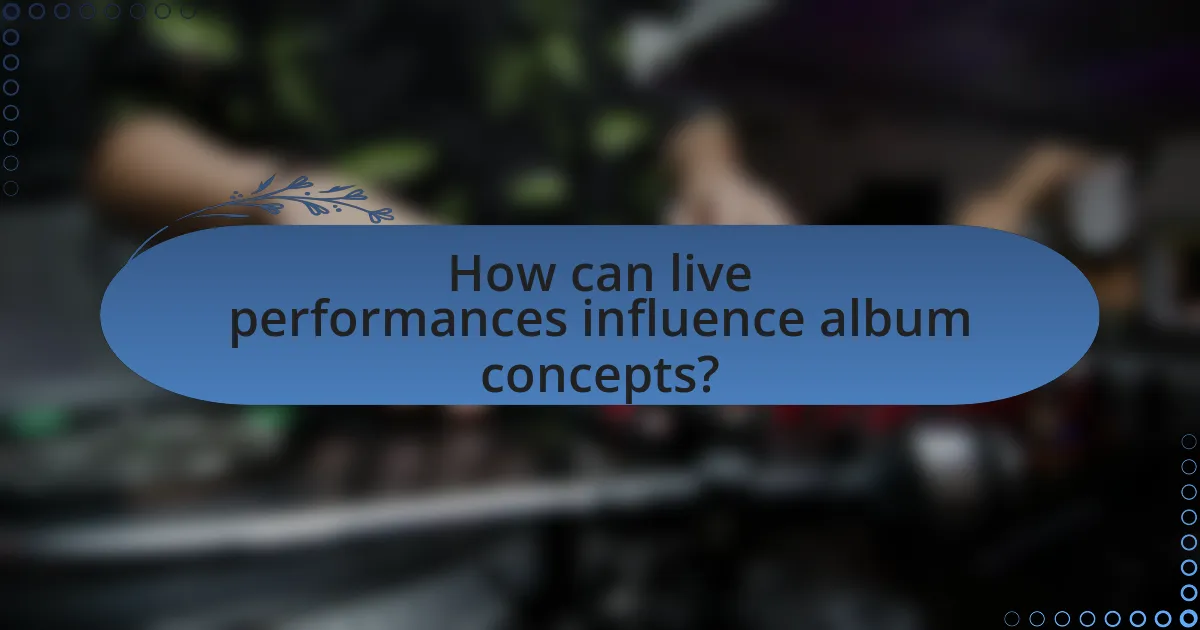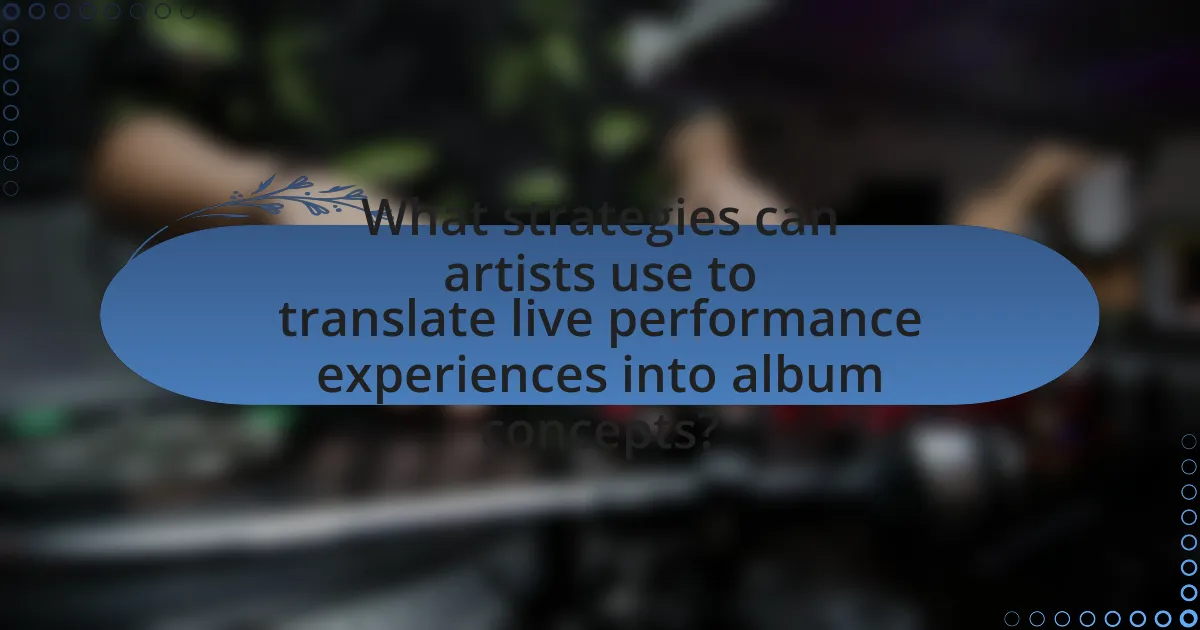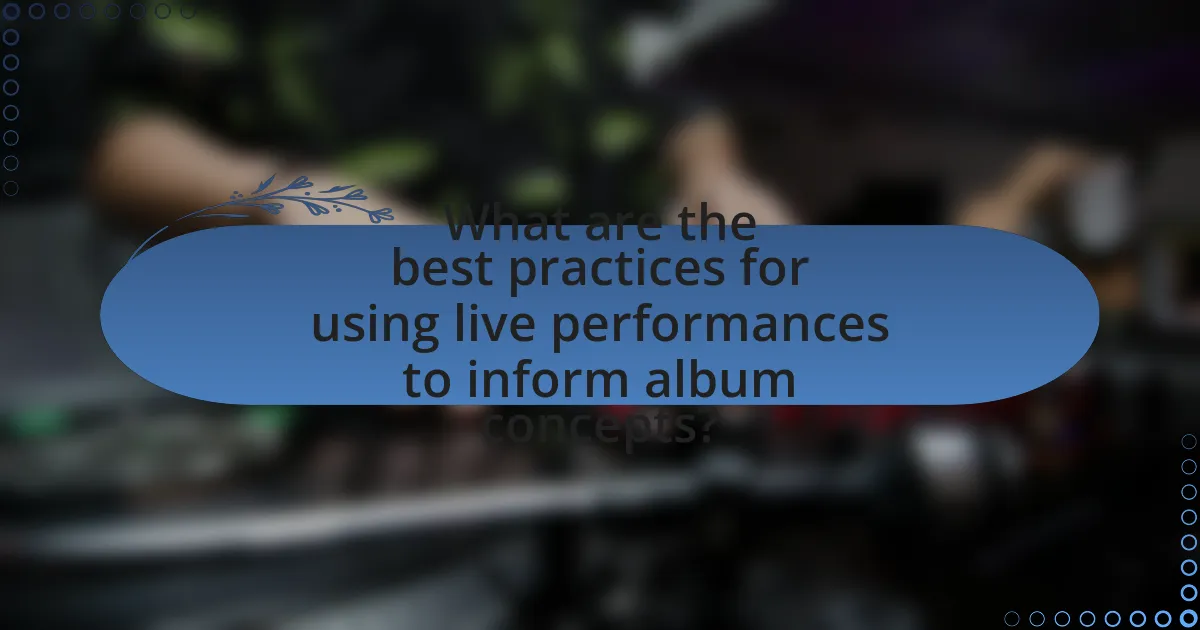The article focuses on the influence of live performances on the development of album concepts. It explores how audience interactions, emotional energy, and visual elements during live shows can shape thematic and stylistic choices in music. Key points include the importance of audience feedback in guiding lyrical direction, the role of stage presence in enhancing conceptual development, and strategies for artists to effectively translate live experiences into their studio work. Additionally, the article discusses potential risks of neglecting live performance insights and offers practical tips for artists to integrate these experiences into their album creation process.

How can live performances influence album concepts?
Live performances can significantly influence album concepts by providing artists with immediate feedback and a deeper understanding of audience reactions. This interaction allows musicians to gauge which songs resonate most, leading to thematic and stylistic adjustments in their albums. For instance, during live shows, artists may notice particular lyrics or melodies that evoke strong emotional responses, prompting them to explore those themes further in their studio work. Additionally, the energy and atmosphere of live performances can inspire the overall sound and production choices for an album, as seen in the evolution of bands like The Rolling Stones, who often adapted their studio recordings based on the dynamics experienced during concerts.
What elements of live performances can inspire album themes?
Live performances can inspire album themes through audience interaction, emotional energy, and visual elements. Audience interaction provides immediate feedback and connection, influencing the lyrical and thematic direction of the album. Emotional energy, generated by the atmosphere and crowd response, can shape the mood and tone of the music, leading artists to explore deeper emotional narratives. Visual elements, such as stage design and lighting, can also inspire thematic concepts, as they create a unique ambiance that artists may want to replicate or expand upon in their recorded work. For example, a performance that evokes a sense of nostalgia might lead to an album exploring themes of memory and reflection.
How do audience reactions shape the direction of an album?
Audience reactions significantly influence the direction of an album by providing immediate feedback that artists can interpret and incorporate into their creative process. When musicians perform live, they observe audience responses to specific songs, lyrics, and arrangements, which can lead to adjustments in the album’s content or style. For instance, if a particular song elicits a strong emotional reaction, artists may choose to develop that song further or create similar tracks that resonate with listeners. Historical examples include Taylor Swift’s shift in sound and lyrical themes after observing fan reactions during her tours, which led to the evolution of her albums from country to pop. This dynamic interaction between audience engagement and artistic direction underscores the importance of live performances in shaping an album’s final form.
What role does stage presence play in conceptual development?
Stage presence significantly enhances conceptual development by creating an engaging atmosphere that fosters audience connection and emotional resonance. This connection allows artists to test and refine their concepts in real-time, receiving immediate feedback on their ideas. For instance, performances can reveal which themes or narratives resonate most with audiences, guiding artists in shaping their album concepts based on this interaction. Research indicates that live performances can lead to a deeper understanding of audience preferences, as noted in studies on audience engagement and emotional response during concerts.
Why is it important to integrate live performance experiences into album creation?
Integrating live performance experiences into album creation is important because it enhances the emotional authenticity and audience connection of the music. Live performances provide artists with immediate feedback from their audience, allowing them to gauge which elements resonate most effectively. This real-time interaction can inform the songwriting process, leading to more relatable and impactful lyrics and melodies. Additionally, incorporating the energy and spontaneity of live shows can inspire innovative arrangements and production choices that reflect the dynamic nature of performance. Research indicates that artists who draw from live experiences often produce albums that better capture the essence of their musical identity, resulting in a more cohesive and engaging listening experience.
How can live performances enhance storytelling in music?
Live performances enhance storytelling in music by creating an immersive experience that engages the audience emotionally and visually. This engagement allows artists to convey deeper narratives through their music, as the live setting amplifies the emotional weight of the lyrics and melodies. For instance, studies show that audiences are more likely to connect with the themes of a song when they experience it live, as the energy and atmosphere of a performance can evoke strong emotional responses. Additionally, artists often use visual elements, such as stage design and lighting, to complement their storytelling, further enriching the narrative experience. This combination of auditory and visual stimuli in live performances effectively deepens the audience’s understanding and appreciation of the story being told through the music.
What are the potential risks of neglecting live performance insights?
Neglecting live performance insights can lead to significant risks, including a disconnect from audience preferences and a lack of innovation in music creation. When artists ignore feedback and data gathered from live performances, they may fail to understand what resonates with their audience, resulting in less engaging music. For instance, a study by Nielsen Music found that 70% of fans prefer artists who actively engage with their live performance experiences, indicating that neglecting these insights can alienate a substantial portion of the fanbase. Additionally, without analyzing live performance metrics, artists may miss opportunities to refine their sound and stage presence, ultimately hindering their growth and relevance in the industry.

What strategies can artists use to translate live performance experiences into album concepts?
Artists can translate live performance experiences into album concepts by capturing the emotional energy and audience interactions from their shows. This can be achieved through recording live performances, which allows artists to analyze audience reactions and identify key moments that resonate. Additionally, artists can incorporate themes or narratives that emerged during live shows, reflecting the atmosphere and stories shared with the audience. For instance, Bruce Springsteen often draws from his live performances to shape the storytelling in his albums, creating a cohesive narrative that mirrors the energy of his concerts. By utilizing these strategies, artists can create albums that authentically represent the live experience, enhancing the connection with their listeners.
How can artists document their live performance experiences effectively?
Artists can document their live performance experiences effectively by utilizing video recordings, audio captures, and written reflections. Video recordings allow artists to visually analyze their stage presence and audience interaction, while audio captures provide insights into sound quality and performance dynamics. Written reflections, such as journals or blogs, enable artists to articulate their thoughts and feelings about the performance, helping them identify key moments and themes. This multi-faceted approach not only preserves the experience but also aids in the creative process for future album concepts, as artists can revisit these materials to inspire new ideas and refine their artistic direction.
What tools can be used to capture audience feedback during shows?
Tools that can be used to capture audience feedback during shows include mobile apps, audience response systems, social media platforms, and post-show surveys. Mobile apps like Slido or Poll Everywhere allow real-time interaction, enabling audiences to submit feedback instantly. Audience response systems, such as clickers, facilitate immediate polling during performances. Social media platforms enable attendees to share their thoughts and experiences live, while post-show surveys can be distributed via email or QR codes to gather detailed feedback after the event. These tools enhance engagement and provide valuable insights into audience preferences and reactions.
How can video recordings of performances aid in concept development?
Video recordings of performances can significantly aid in concept development by providing visual and auditory feedback that informs artistic direction. These recordings allow artists to analyze their stage presence, audience engagement, and overall performance dynamics, which can lead to refined concepts for future projects. For instance, observing audience reactions in real-time can help artists identify which elements resonate most, guiding them in shaping their album themes and narratives. Additionally, video analysis can reveal strengths and weaknesses in performance techniques, enabling artists to adjust their creative approach accordingly. This method of reflection is supported by studies indicating that visual feedback enhances learning and adaptation in creative fields, thus validating the effectiveness of using video recordings for concept development.
What collaborative approaches can enhance the development of album concepts from live performances?
Collaborative approaches that can enhance the development of album concepts from live performances include co-writing sessions among band members, engaging with audience feedback, and incorporating input from producers and sound engineers. Co-writing sessions allow artists to brainstorm and refine ideas based on the energy and themes that emerge during live shows. Engaging with audience feedback, such as through social media or post-show discussions, provides insights into which songs resonate most, guiding the album’s direction. Additionally, input from producers and sound engineers can help shape the sound and arrangement of tracks, ensuring that the album captures the essence of the live performance experience. These methods have been utilized by various artists, such as The Beatles and Coldplay, who have successfully integrated live performance elements into their studio albums, resulting in cohesive and impactful projects.
How can band members contribute different perspectives from live shows?
Band members can contribute different perspectives from live shows by sharing their individual observations and experiences during performances. Each member may notice distinct audience reactions, sound quality variations, or emotional connections that can inform the creative direction of an album. For instance, a guitarist might focus on how the crowd responds to specific solos, while a vocalist may emphasize the emotional impact of lyrics during certain songs. These varied insights can lead to a more comprehensive understanding of the band’s live dynamics, ultimately shaping the themes and arrangements of future recordings.
What role do producers and sound engineers play in this process?
Producers and sound engineers play crucial roles in shaping the sound and overall quality of an album developed from live performances. Producers oversee the creative direction, making decisions on arrangements, instrumentation, and the overall vision for the album, while sound engineers focus on capturing and manipulating audio to ensure clarity and balance in the final product. Their collaboration is essential; for instance, a producer may suggest changes based on the live performance’s energy, while the sound engineer implements technical adjustments to enhance the recording quality. This synergy ensures that the essence of the live experience is effectively translated into the album format, resulting in a polished and engaging final product.

What are the best practices for using live performances to inform album concepts?
The best practices for using live performances to inform album concepts include analyzing audience reactions, incorporating improvisation, and utilizing thematic elements from the performance. Artists should observe how audiences respond to different songs and arrangements during live shows, as this feedback can highlight which elements resonate most. For example, a study by the University of Southern California found that live audience engagement can significantly influence an artist’s creative direction. Additionally, artists can experiment with improvisation during performances, allowing them to discover new musical ideas that can be developed into album tracks. Finally, integrating thematic elements from the live experience, such as visual aesthetics or storytelling, can create a cohesive concept for the album that reflects the energy and atmosphere of the performance.
How can artists create a feedback loop between live performances and studio work?
Artists can create a feedback loop between live performances and studio work by actively incorporating audience reactions and performance experiences into their songwriting and production processes. This approach allows artists to gauge which elements resonate with audiences, enabling them to refine their music based on real-time feedback. For instance, artists can record live performances to analyze audience engagement and identify successful musical elements, which can then be integrated into studio recordings. Additionally, artists can use social media and direct audience interactions to gather insights on their performances, further informing their studio work. This iterative process enhances the relevance and emotional impact of their music, as evidenced by numerous successful artists who adapt their studio projects based on live performance experiences.
What methods can be employed to analyze audience engagement during performances?
Methods to analyze audience engagement during performances include real-time feedback collection, audience response systems, and social media monitoring. Real-time feedback collection can be achieved through mobile apps or surveys distributed during or immediately after the performance, allowing performers to gauge audience reactions and preferences. Audience response systems, such as clickers or mobile polling, enable immediate interaction and provide quantitative data on audience engagement levels. Social media monitoring involves tracking mentions, hashtags, and audience interactions on platforms like Twitter and Instagram, offering insights into audience sentiment and engagement trends. These methods are validated by studies showing that real-time feedback can enhance performance quality and audience satisfaction, as evidenced by research conducted by the University of Southern California, which found that immediate audience input significantly influences performers’ adjustments and overall engagement.
How can artists adapt their live set to refine album concepts?
Artists can adapt their live set to refine album concepts by incorporating thematic elements, adjusting arrangements, and engaging with the audience. By integrating visual storytelling and stage design that aligns with the album’s narrative, artists can enhance the overall experience and reinforce the album’s themes. Additionally, modifying song arrangements to highlight specific lyrical content or emotional arcs allows for a deeper exploration of the album’s concepts during performances. Engaging with the audience through interactive elements or storytelling can also provide valuable feedback, helping artists to understand which aspects resonate most and may need further development. This approach is supported by the fact that live performances serve as a testing ground for new material, allowing artists to gauge audience reactions and refine their artistic vision accordingly.
What common pitfalls should artists avoid when developing album concepts from live performances?
Artists should avoid the pitfall of relying solely on audience reactions when developing album concepts from live performances. This can lead to a misalignment between the artist’s vision and the expectations of the audience, resulting in a product that lacks authenticity. Additionally, artists should not overlook the importance of thematic coherence; failing to create a unified concept can dilute the impact of the album. Another common mistake is neglecting the recording quality; live performances often capture raw energy but may not translate well into a polished album format. Lastly, artists should avoid the temptation to include every song performed live, as this can lead to an unfocused album that lacks a clear narrative or direction.
How can over-reliance on audience feedback hinder artistic vision?
Over-reliance on audience feedback can hinder artistic vision by causing artists to prioritize popular opinion over their creative instincts. When artists excessively seek validation from their audience, they may dilute their unique style and message to cater to mainstream preferences. This shift can lead to a loss of authenticity, as evidenced by numerous musicians who have altered their sound based on audience reactions, resulting in a departure from their original artistic intent. For instance, artists like Taylor Swift have faced criticism for changing genres to align with audience expectations, which can compromise their artistic integrity and vision.
What strategies can prevent the dilution of an artist’s original concept?
To prevent the dilution of an artist’s original concept, maintaining a clear vision and consistent communication throughout the creative process is essential. Artists should establish a detailed concept document that outlines their vision, themes, and objectives for the album, ensuring that all collaborators understand and align with this vision. Regular feedback sessions can help to reinforce the original concept, allowing for adjustments while keeping the core intact. Additionally, limiting the number of collaborators can reduce conflicting interpretations, thereby preserving the artist’s intent. Historical examples, such as Prince’s meticulous control over his music and image, demonstrate the effectiveness of these strategies in maintaining artistic integrity.
What practical tips can artists follow to effectively use live performances in album development?
Artists can effectively use live performances in album development by incorporating audience feedback, testing new material, and refining their sound. Engaging with the audience during performances allows artists to gauge reactions to songs, which can inform decisions on track selection and arrangement. For instance, a study by the University of Southern California found that artists who actively sought audience input during shows were more likely to create commercially successful albums. Additionally, performing new songs live helps artists identify which tracks resonate most, enabling them to focus on the strongest material for their album. Finally, live performances provide an opportunity to experiment with arrangements and instrumentation, allowing artists to refine their sound before recording.